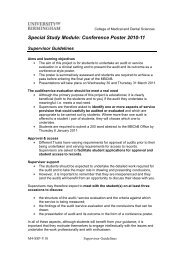Contents - College of Medical and Dental Sciences - University of ...
Contents - College of Medical and Dental Sciences - University of ...
Contents - College of Medical and Dental Sciences - University of ...
You also want an ePaper? Increase the reach of your titles
YUMPU automatically turns print PDFs into web optimized ePapers that Google loves.
The 11 th International Workshop on KSHV & Related Agents, Birmingham, UK<br />
Immunology II Abstract 47<br />
INFECTION OF LYMPHOID CELLS BY KSHV IN CULTURED PRIMARY HUMAN<br />
TONSILLAR LYMPHOID CELLS EX VIVO<br />
Jinjong Myoung <strong>and</strong> Don Ganem<br />
HHMI <strong>and</strong> Departments <strong>of</strong> Microbiology <strong>and</strong> Medicine, UCSF<br />
Abstract<br />
KSHV is known to infect B cells in vivo <strong>and</strong> is a causative agent <strong>of</strong> rare human B cell<br />
lymphomas (PELs). Paradoxically, however, established B cell lines are resistant to<br />
infection in vitro, which has greatly retarded progress in underst<strong>and</strong>ing the biology <strong>of</strong><br />
KSHV in its natural lymphoid compartment. We prepared primary human lymphoid<br />
aggregate cultures (HLACs) from tonsils, <strong>and</strong> examined their infectability by KSHV.<br />
Recombinant virus (rKSHV.219) expressing GFP under the EF1α promoter was prepared<br />
from induced Vero cells latently infected with this virus. Tonsil cells were infected with<br />
rKSHV, then subjected to flow cytometric analysis. When tonsil cells were infected with<br />
an MOI <strong>of</strong> 0.75, 15% <strong>of</strong> CD19+ cells became GFP-positive. Surprisingly, in the same<br />
culture many more T cells (54% <strong>of</strong> CD3+ cells) were shown to be GFP+; CD8+ T cells<br />
were consistently more susceptible than CD4+ T cells. This difference in infectivity in T<br />
cell subsets became more prominent when PHA was used to activate the T cells prior to<br />
infection. When exposed to chemical inducers <strong>of</strong> lytic growth, infected HLAC cultures<br />
displayed enhanced production <strong>of</strong> infectious KSHV.214, demonstrating that HLACs are<br />
competent to support the complete lytic cycle <strong>of</strong> KSHV. No immortalization or blastic<br />
transformation has yet been observed in infected HLACs. However, GFP+ B cells were<br />
significantly enriched when assessed at d13 post-infection, while the proportion <strong>of</strong> GFP+<br />
T cells decreased significantly by d13 PI. These data suggest that KSHV infection<br />
provides survival advantage in B cells, but not in T cells.<br />
Presenting author Email: jinjong.myoung@ucsf.edu<br />
73















